
|
Astronomy Picture Of the Day (APOD)
 Comet Kudo-Fujikawa: Days in the Sun
Comet Kudo-Fujikawa: Days in the Sun
29.01.2003
Cruising through the inner Solar System, new Comet Kudo-Fujikawa reached perihelion, its closest approach to the Sun, yesterday, January 29. Passing within 28.4 million kilometers of the Sun, this comet came much closer than innermost planet Mercury basking only 57.9 million kilometers from our parent star.
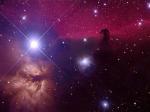 Orions Horsehead Nebula
Orions Horsehead Nebula
28.01.2003
The Horsehead Nebula is one of the most famous nebulae on the sky. It is visible as the dark indentation to the red emission nebula seen above and to the right of center in the above photograph. The bright star on the left is located in the belt of the familiar constellation of Orion.
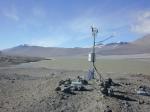 The Lost World of Lake Vida
The Lost World of Lake Vida
27.01.2003
A lake hidden beneath 19 meters of ice has been found near the bottom of the world that might contain an ecosystem completely separate from our own. In a modern version of Sir Arthur...
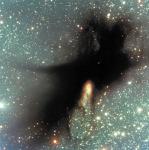 BHR 71: Stars, Clouds, and Jets
BHR 71: Stars, Clouds, and Jets
26.01.2003
What is happening to molecular cloud BHR 71? Quite possible, a binary star system is forming inside. Most stars in our Galaxy are part of binary star systems, but few have ever been seen in formation.
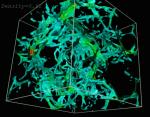 The Lyman Alpha Forest
The Lyman Alpha Forest
25.01.2003
We live in a forest. Strewn throughout the universe are "trees" of hydrogen gas that absorb light from distant objects. These gas clouds leave numerous absorption lines in a distant quasar's spectra, together called the Lyman-alpha forest.
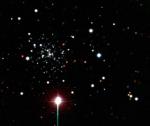 Palomar 13 s Last Stand
Palomar 13 s Last Stand
24.01.2003
Globular star cluster Palomar 13 has roamed the halo of our Milky Way Galaxy for the last 12 billion years. The apparently sparse cluster of stars just left of center in this composite color digital image, it is one of the smallest, faintest globular clusters known.
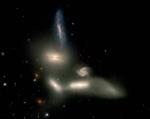 Seyfert's Sextet
Seyfert's Sextet
23.01.2003
Known as Seyfert's Sextet, this intriguing group of galaxies lies in the head portion of the split constellation Serpens. The sextet actually contains only four interacting galaxies, though. Near the center of this...
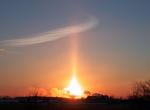 Launch of the Sun Pillar
Launch of the Sun Pillar
22.01.2003
On January 16, NASA's space shuttle Columbia roared into blue morning skies above Kennedy Space Center on STS-107, the first shuttle mission of 2003. But this is not a picture of that launch!
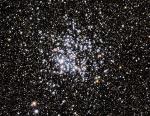 M11: The Wild Duck Cluster
M11: The Wild Duck Cluster
21.01.2003
Many stars like our Sun were formed in open clusters. The above pictured open cluster, M11, contains thousands of stars and is just over five thousand light years distant. The stars in this cluster all formed together about 250 million years ago. The bright young stars in M11 appear blue.
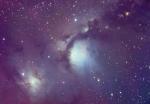 The Reflecting Dust Clouds of Orion
The Reflecting Dust Clouds of Orion
20.01.2003
In the vast Orion Molecular Cloud complex, several bright blue nebula are particularly apparent. Pictured above are two of the most prominent reflection nebulas -- dust clouds lit by the reflecting light of bright-embedded stars. The more famous nebula is M78, on the upper right, cataloged over 200 years ago.
|
January February March April May June July August September October November December |
|||||||||||||||||||||||||||||||||||||||||||||||||